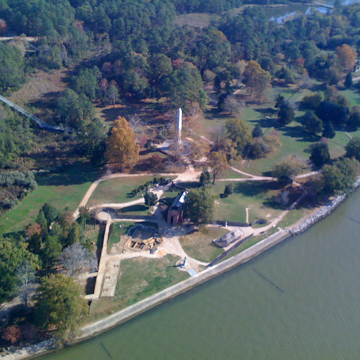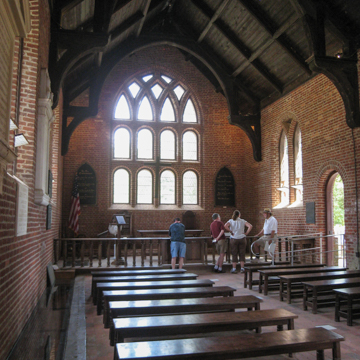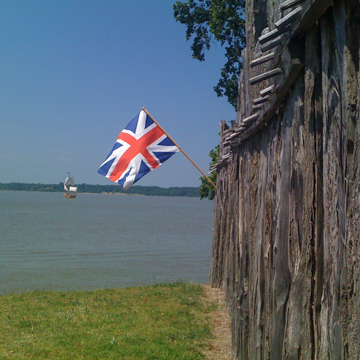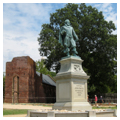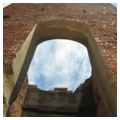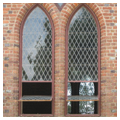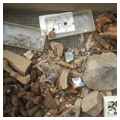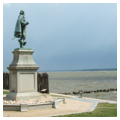Jamestown was England's seventeenth-century base camp on a faraway planet called Virginia. Like space stations today, the original (1607) fort and the settled town that it later became served as laboratories where colonists tested alternative strategies for making an alien environment safe and productive. Jamestown's manifest failures succeeded brilliantly in teaching Englishmen what not to expect from towns and cities in the southern American colonies.
No sooner had the colonial capital removed to Middle Plantation (renamed Williamsburg) in 1699 than Jamestown became a mecca for pilgrims. Its centennial and bicentennial were celebrated in 1707 and 1807, and since 1857 anniversaries have been observed every fifty years. These jubilees were mixed blessings. They attracted relic hunters who carried off genuine antiquities and ancestor worshippers who left behind dubious reliquaries. True preservation began only in 1893 when the Association for the Preservation of Virginia Antiquities acquired 22.5 acres at the western end of the island, including the churchyard and ruined bell tower of the former James City Parish Church (c. 1680), to which Boston architect Edmund M. Wheelwright grafted a memorial church in 1907. The APVA added two statues, Pocahontas (1907, William Ordway Partridge) and Captain John Smith (1907, William Couper). The National Park Service rescued the rest of the island in
Recently the island's two stewards have reevaluated and renewed that earlier work in preparation for the 400th anniversary observance in 2007. New Park Service scholarship and the unexpected discovery of the original fort site by William Kelso and APVA archaeologists (underneath the 1861 Confederate earthworks) have clarified Jamestown's role as an experimental station on the edge of England's Chesapeake empire. Archaeologists have identified four trial phases, each of which left its marks. (References are to various ruins, outlines, and other items on display on the site.)
Experiment 1: trading post. The expeditionary force that sailed up the James River in 1607 was searching for a place to build a trade castle, modeled after those run by the Portuguese in West Africa and Zanzibar. The first Englishmen came as middlemen, not settlers, counting on the Indians to supply them with riches from the interior just as Africans supplied the Portuguese with gold, slaves, and ivory. The triangular palisaded fort (rediscovered in 1994) enclosed warehouses, workshops, and barracks for the small staff of merchants, artisans, and soldiers needed to manage that trade.
Experiment 2: manufacturing center. The Algonquian Indians of the region disappointed those expectations. They had their own agenda, specifically, to tolerate the newcomers but subordinate them to the confederacy ruled by Chief Powhatan. Quickly perceiving their miscalculation, the directors of the Virginia Company set new goals. Henceforth the colony would pay back its investors by recruiting settlers and slaves to grow cash crops, notably tobacco after 1619, and by developing lucrative “projects,” among them silk production and glassmaking (the 1608 glasshouse was reconstructed in 1957). Jamestown soon outgrew the fort, and entrepreneurs began to build warehouses (Structure 26) and numerous kilns (Structures 111 and 127), potteries (Structure 111), forges (Structure 24), and other heavy industries along the riverfront and adjoining Pit and Tar Swamp. Governors John Harvey and William Berkeley vigorously promoted the town as a port of entry and manufacturing center. Their ambitions were thwarted by English merchants and royal officials.
Experiment 3: speculative new town. England's commercial expansion after 1660 revived the idea of Jamestown as entrepôt. This time the Virginia Assembly authorized higher taxes and made sweetheart deals with private developers to encourage merchants and planters to build stores and brick town houses along the streets behind the waterfront. At least three row houses (Structures 17, 115, and Ludwell Statehouse Row) and a brick tavern (Structure 19) were built or enlarged in response to the 1662 Town Act. Their placement hints at a plan to create a large urban square. But the speculative bubble burst even before Nathaniel Bacon's rebel army sacked the town in 1676.
Experiment 4: seat of government. The flames devoured the speculators' dreams, but not the ruling gentry's determination to dignify the Jamestown capital. The courts, council, and assembly had always rented meeting rooms in taverns and private dwellings or gathered at the official residence—the “country's house”—of the governor. The term “statehouse” followed them wherever they sat. The General Assembly and the House of Burgesses began to meet in a purpose-built statehouse (refurbished Structure 112) only in the mid-1660s. But not for long. Bacon's insurgents burned it to the ground a decade later. Undaunted, the town fathers rebuilt it in 1684 as the centerpiece of their civis urbis. Alas, again not for long. An accidental fire destroyed the second and last formal statehouse in 1698 and, with it, all hopes for Jamestown as capital.
The spirit of experimentation survived, but not on Jamestown Island. Wealthy boosters at up-and-coming Middle Plantation played politics to move the capital—and the next attempt at town building—to Williamsburg.


